After a 60-102 season in 2022, expectations are low for the Oakland Athletics in 2023.
While that may be tough for Athletics fans to stomach (especially in the midst of possible “moving to Vegas” talks), it also opens up opportunities for more playing time for young players in Oakland this season.
The Athletics rotation will be a prime area this season where many pitchers will get to prove if they can not just be long-term options, but perhaps “top of the rotation” pitchers as well.
Over the past two offseasons, the Oakland rotation has seen the departures of former rotation standouts such as Chris Bassitt, Sean Manaea, and Frankie Montas. Also in late January this year, the Athletics traded away Cole Irvin, a possible Opening Day pitcher candidate, to Baltimore for infield prospect Darrell Hernaiz.
The Baltimore Orioles have acquired left-hander Cole Irvin in a trade with the Oakland A's, sources tell ESPN. Infield prospect Darell Hernaiz is headed back to the A's.
— Jeff Passan (@JeffPassan) January 26, 2023
And if that wasn’t enough, on February 11th, Oakland traded A.J. Puk to the Miami Marlins for outfielder JJ Bleday.
Trade news: The Oakland A’s and Miami Marlins are swapping former top 6 picks. Outfielder JJ Bleday is headed to the A’s, and left-hander A.J. Puk is going to the Marlins. @Ken_Rosenthal was on the deal first.
— Jeff Passan (@JeffPassan) February 12, 2023
While Puk pitched out of the bullpen last season, there were rumors that Puk was being developed to move back into the rotation in 2023. The departures of Irvin and Puk will open up some spots for the young pitchers in the Athletics’ system, and it will be intriguing to see which of Oakland’s young arms will emerge in Spring Training over the next month.
And no young pitcher in the Athletics’ system may be more intriguing than Ken Waldichuk, who may have the most upside right now of any starting pitching candidate for Oakland this Spring.
Waldichuk’s Debut in 2022
At the Trade Deadline last year, the Athletics received not only Waldichuk but also pitchers JP Sears and Luis Medina, as well as second baseman Cooper Bowman from the Yankees. Waldichuk was one of the more heralded of the bunch, as Baseball America ranked him as the No. 10 prospect in the Yankees system prior to the start of the 2022 season, and the Athletics’ No. 5 prospect in-season after the trade.
Waldichuk made his debut on September 1st against the Nationals last year and had a solid showing in 4.2 IP in the Nation’s Capital. While he did walk four batters and allow five hits, he struck out six and only allowed one run to boot.
Impressive MLB debut for @Athletics No. 3 prospect Ken Waldichuk:
4.2 IP
5 H
1 ER
4 BB
6 K pic.twitter.com/8JWBARF77d— MLB Pipeline (@MLBPipeline) September 1, 2022
For the season, Waldichuk produced a 4.93 ERA in seven starts and 34.2 IP. The ERA was a bit high, and he did suffer from some rough home run metrics (1.30 HR/9; 11.6 HR/FB rate). On the other hand, he showed a strong ability to strike batters out (22.6 percent K rate) and limit walks (15.8 percent K-BB rate) after a rough debut start.
That improvement in control was illustrated in his rolling walk rate chart from last season, via Savant. After his four-walk outing against the Nationals, he was pretty much below the league average in walk rate allowed, which can be seen below:
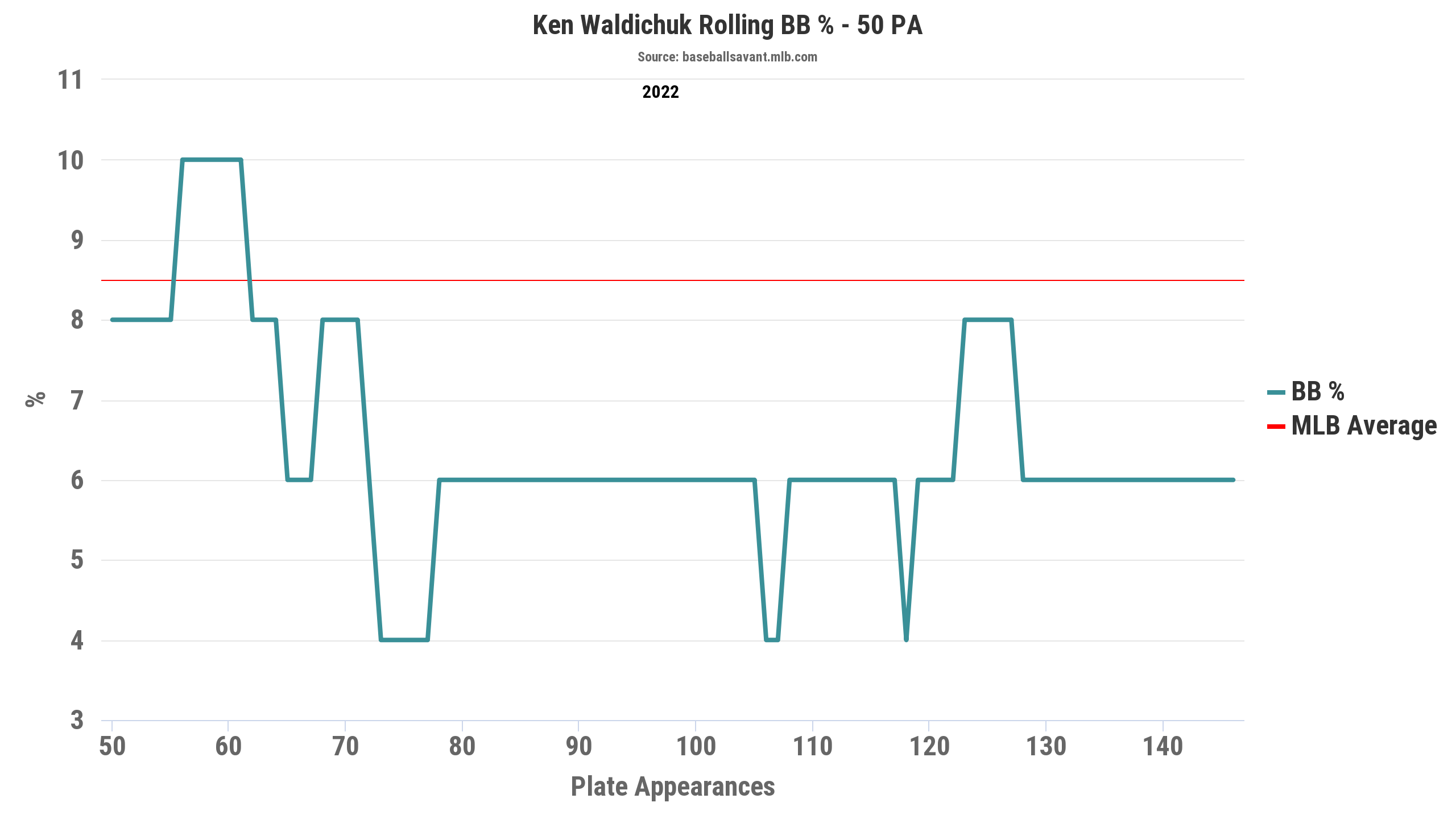
Courtesy of Baseball Savant
While his walk rate trended in the right direction for him as he pitched more innings in the Majors, the same proved to be true in terms of striking batters out.
Waldichuk flirted with a strikeout rate that was below league average at first. However, he saw a spike in that rate after the 110th plate appearances mark, and it pretty much stayed above the league-average benchmark for the remainder of the season, which can be seen in the rolling K rate chart below, via Savant.
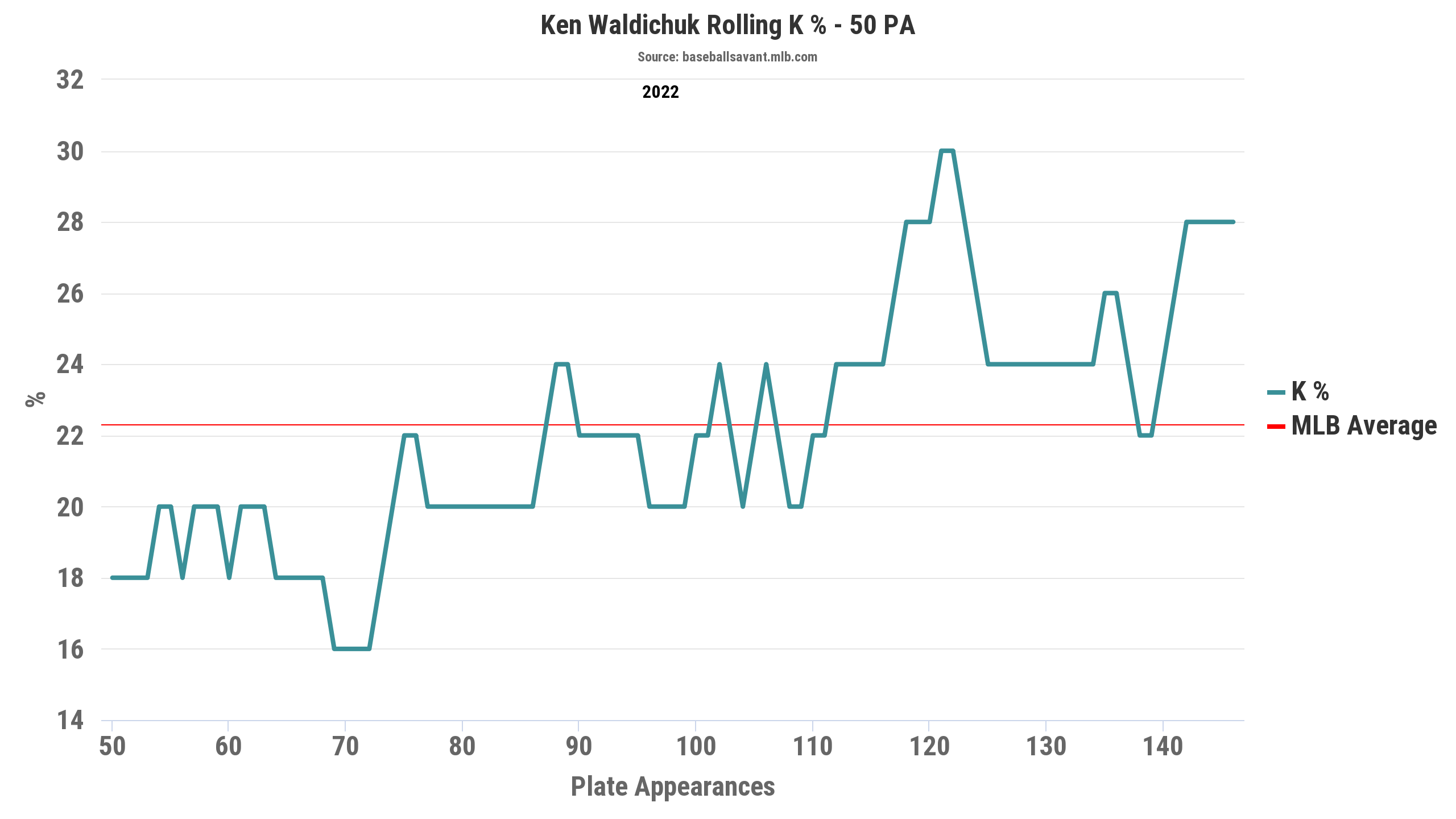
Courtesy of Baseball Savant
Based on these trends, it shouldn’t be a surprise that Waldichuk’s FIP, xERA, and xFIP outperformed his 4.93 ERA from a season ago.
Furthermore, when comparing him to other starting pitcher options for the A’s this season, Waldichuk compares more favorably than the competition when looking at those non-ERA metrics.
Roster Resource is currently projecting Waldichuk to nab the fifth spot in the Oakland rotation going into Spring Training. Returning Athletics starting pitchers Paul Blackburn and James Kaprielian are expected to fill in two of the spots, and Drew Rucinski and Shintaro Fujinami are predicted to grab the other two slots after pitching in the KBO and NPB last season, respectively.
So, Waldichuk is far from a “sure thing” to begin the year in the A’s rotation.
And what may solidify his spot, both now and in the future, could depend on the development of his four-seam fastball in 2023.
Control Issues with the Four-Seamer?
According to Baseball Savant, Waldichuk’s four-seam fastball velocity ranked in the 60th percentile, and his four-seam spin ranked in the 75th percentile as well. Therefore, the pitch has the properties to succeed, but it didn’t happen consistently enough in Waldichuk’s limited debut with the Athletics in 2022.
Let’s take a look at the strike and swing data of his four-seam fastball from a season ago, and how Waldichuk’s four-seamer compared to the league average.
When it came to generating whiffs and hitting the zone with his four-seamer, Waldichuk was comfortably above the league average.
On the other hand, his biggest issue was generating called strikes with the pitch last season. His 11.2 percent called-strike rate (CS%) was 6.4 percent below the league average, and that was a big reason why his CSW rate with the pitch was 3.9 percent below the league average as well.
In terms of what those called strikes and balls looked like with the four-seamer, one can see when comparing their respective pitch heatmaps that Waldichuk made it a priority to hit the top of the zone with his four-seamer. Unfortunately, he just missed up way too often with the pitch.
- Courtesy of Baseball Savant
- Courtesy of Baseball Savant
Here’s a GIF comparison between a ball that misses up in the strike zone against the Angels and a pitch that hits that red area of the called-strike heatmap against the Nationals.
https://gfycat.com/baggygleefulchafer
Just from the first glance of the GIFs above, it’s obvious that there are mechanical issues with Waldichuk’s release on the pitch to Shohei Ohtani which is called a ball. In fact, it seems like Waldichuk’s control issues with the four-seamer, in general, may be tied to his inconsistent release of the four-seamer.
Here’s a side-by-side comparison of his release point with both pitches, and notice the called-ball pitch is being released way too early, which results in it wildly missing out of the strike zone.
- Courtesy of Baseball Savant
- Courtesy of Baseball Savant
It’s also intriguing to see in the ball image how the catcher is setting up on the outside edge of the strike zone. And yet, Waldichuk misses up and inside in spectacular fashion.
A big reason for that is the early release of the ball from his hand.
In the strike to Voit, Waldichuk is not releasing it until his hand is around or beyond his shoulder, which gives him better command of the pitch. In the ball to Ohtani, Waldichuk is releasing it behind his shoulder, which causes the four-seam movement to tail up and arm side, the opposite of where he needs to locate it in that particular situation. The called ball heatmap on the four-seamer seems to illustrate that happened a lot more often than just that particular at-bat to Ohtani.
Results such as that one typically hint at inconsistent mechanics when throwing the four-seamer. And thus, it will be interesting to see if Oakland pitching coach Scott Emerson can help him develop consistency with his release, especially on the four-seamer this Spring.
PLV Potential with the Four-Seamer
One of Pitcher List’s new metrics that is available with the recent release of PL 8 is Pitch Level Value (PLV), which mirrors similarly to Eno Sarris’ Pitching+ and Cameron Grove’s PitchingBot. PLV metrics give a clearer insight into pitch quality and context with particular pitches, especially from a pitcher’s perspective.
And the PLV of Waldichuk’s four-seamer hints at some interesting upside with the pitch, especially heading into the 2023 season.
Here’s a look at Waldichuk’s four-seamer PLV metrics from a season ago, which lists not only percentiles for each category, but also how his four-seamer compared to the league average in that particular category.
It’s interesting to see how the results were a bit of a “feast or famine” with his four-seamer, especially when looking at the quality pitch (QP%), average pitch (AP%), and bad pitch (BP%) metrics.
Waldichuk’s QP percentage was 42 percent, which ranked him in the 70th percentile. His BP percentage was 38.1 percent, which ranked in the 60th percentile, which is not bad either. On the other hand, his AP percentage ranked in the 31st percentile, which means that on a PLV end, there was a bit of an inverse bell curve with QP, AP, and BP numbers.
Now the BP percentage on his four-seamer will be something to pay attention to in 2023, especially considering he benefitted from some better-than-league-average hit luck with his four-seamer last year.
Waldichuk’s xwOBA rolling chart on his four-seamer confirmed the batted ball luck somewhat, especially since his xWOBA on his the pitch was so high for most of his starts last year.
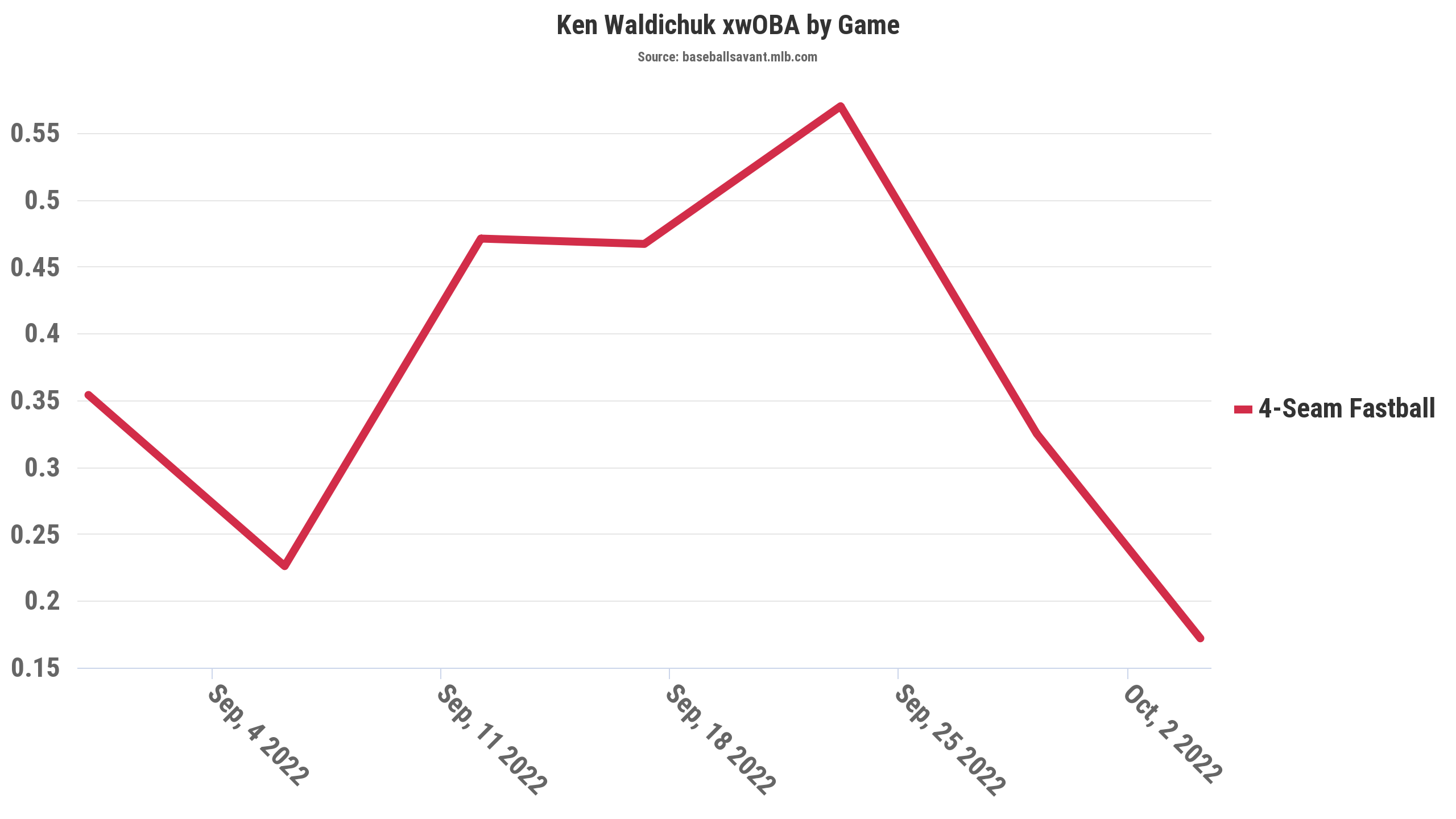
Courtesy of Baseball Savant
It’s also interesting to note how hitters fared in different areas of the strike zone against his four-seamer in 2022. Based on the wOBA zone chart via Savant, hitters seemed to have a lot of success against the four-seamer when it was thrown in zones 1, 4, 6, and 8, which can be seen below:
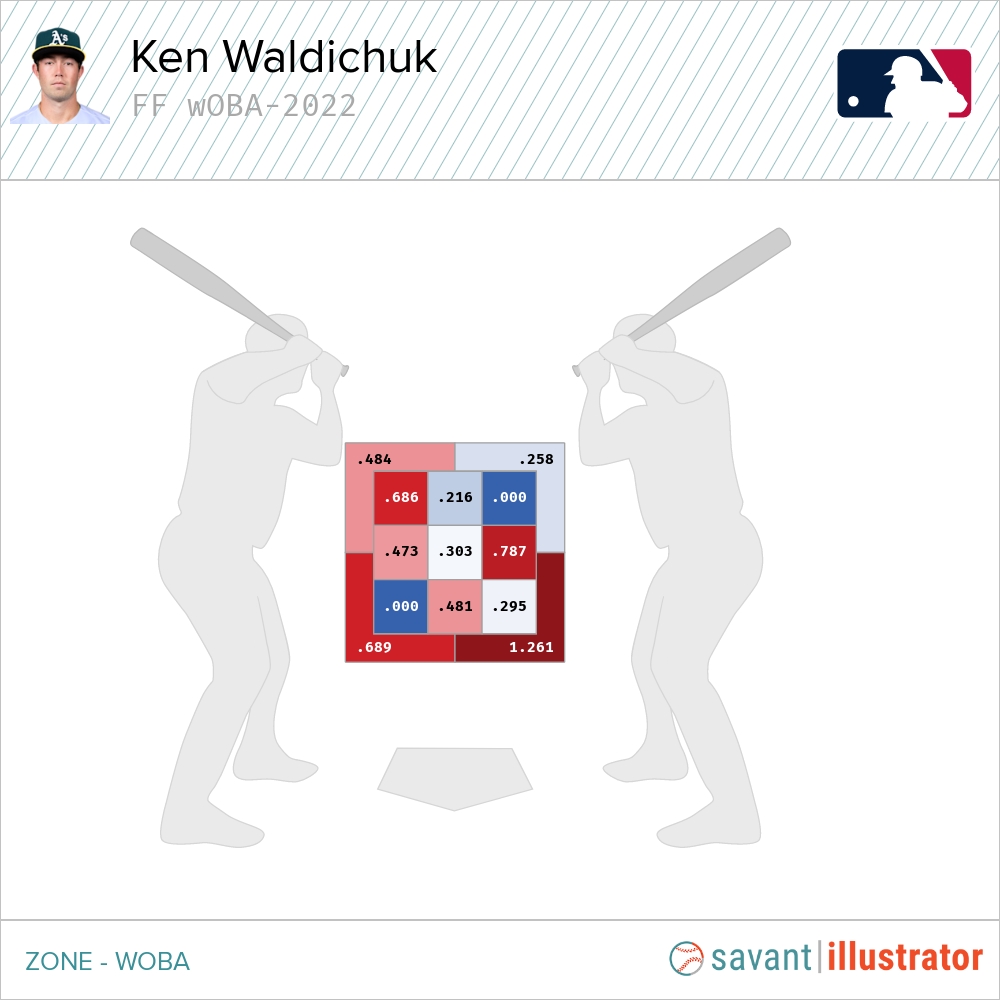
Courtesy of Baseball Savant
In the clip compilation below, let’s take a look at Waldichuk grooving a “bad pitch” in that zone 1 area to Atlanta’s Dansby Swanson, and also throwing a four-seamer with similar velocity and movement in zone 2 to Seattle’s Mitch Haniger.
https://gfycat.com/lividcalculatinggrassspider
Location is the key between the two pitches. When thrown in that zone 1 area, good hitters like Swanson take advantage. However, when commanded more up and in the middle, Waldichuk’s four-seamer could produce ideal results, like that strikeout against Haniger.
On a PLV end, it will be important to monitor if Waldichuk can see some of those “bad pitches” transition to more “average pitches” in 2023, especially since it is likely that the hit luck will regress in 2023.
If that pitch quality trend does happen, Waldichuk could see some growth and improvement in his overall metrics for the upcoming season, which could help him be one of the Athletics’ more dependable starting pitchers.
Success With the Slider and Changeup
When it comes to secondary offerings, Waldichuk primarily relies on a slider that he throws 20 percent of the time and a changeup that he throws 15 percent of the time, according to Pitcher List pitch usage data.
Both pitches have been effective tools for Waldichuk in terms of generating strikes, which can be seen in the swing and strike data table below:
The slider has been an effective chase pitch for Waldichuk, and the pitch also does a good job of limiting contact and generating swings and misses. The pitch sports tremendous horizontal movement, as it demonstrated a horizontal break of 17.8 inches last year, which was 6.5 inches more than the league average last season.
Here’s an example of the massive horizontal movement on the pitch, fooling Seattle’s Jarred Kelenic badly on a 3-2 count in Waldichuk’s September 30th start in Seattle.
https://gfycat.com/necessaryplaindungbeetle
That said, the changeup may be the more impressive offering, as it not only produces a high CSW rate, but it also does a good job of catching the zone for called strikes in comparison to the slider. Considering Waldichuk’s called-strike issues with the four-seamer, having that kind of called-strike potential with the changeup does give Waldichuk some intriguing upside.
Corbin Young of Baseball HQ noted in a Tweet how Waldichuk’s changeup has potential, especially since the pitch did a good job of suppressing hard hits, in addition to generating called and swinging strikes, especially against right-handed hitters.
✍️In the minors, Ken Waldichuk flashed strikeout upside & control issues➡️35.3% K% & 10.2% BB%
👀Debut SZN➡️3 pitches w/ a double-digit SwK%:
✅4-Seam (10%)
✅Slider (16.1%)
✅Changeup (14.1%)Vs RHH:
🤢4-Seam: .741 SLG & .500 wOBA
🧐Changeup: .389 SLG & .287 wOBA🤪OAK SP ADP pic.twitter.com/2DbAqZqIoY
— Corbin (@corbin_young21) January 23, 2023
Waldichuk’s four-seam improvement will be the most crucial matter for him and the A’s coaching staff to focus on this Spring in Cactus League play. On the other hand, Waldichuk’s impressive secondary offerings could make Waldichuk an even more productive pitcher on the mound in 2023 and beyond, especially based on the data from the slider and changeup a season ago.
Overall Outlook
From a baseball perspective, Waldichuk should be a candidate to earn a spot in the rotation, barring a disastrous Spring. The big arms he will have to hold off in camp will not only be Medina, who also came over to Oakland from the Yankees organization in the Montas trade but Kyle Muller who was acquired by the Athletics in the Sean Murphy trade with Atlanta.
Already this Spring, Muller has gotten some attention and buzz from second-year Oakland manager Mark Kotsay.
First look at Kyle Muller (6-7, 250) in the kelly green 🤩
Mark Kotsay said a couple days ago, "Pretty impressive. Kinda Mulder-Bumgarner mix." pic.twitter.com/onStstZ5Yk
— The Rickey Henderson of Blogs (@RickeyBlog) February 19, 2023
When looking at the overall swing and strike data from Oakland starting pitcher candidates, Muller and Waldichuk compare similarly, though Muller outshines Waldichuk on an overall CSW rate end.
Granted, Muller’s sample size is the smallest of that group of four, as he only pitched 12.1 innings in 2022 with Atlanta. In addition, Muller showed some blemishes in Statcast batted ball data, which should give some hesitance to those who think Muller could get that last spot in the rotation over Waldichuk.
Even though Muller’s xERA wasn’t as bad as his ERA hinted last year, it still was the worst mark of those four Oakland starting pitcher candidates last season. As for Waldichuk, while he had the second-highest ERA of that bunch, he also had the second-best xERA and second-lowest max EV average as well (though the best mark in that category belonged to Muller).
It will be a battle this Spring between Muller and Waldichuk for a spot in the Athletics rotation, and that explains why his ADP is around 452nd overall, according to Fantasy Pros. It’s hard to totally buy in on Waldichuk from a fantasy perspective when it’s not a guarantee that he’ll be pitching with the Athletics on Opening Day.
On the other hand, there is a lot of upside and potential with Waldichuk, and he needs to be monitored closely once Cactus League play begins, especially for fantasy managers who play in AL-only or deep league and dynasty formats.
If he can clean up his mechanics slightly on his four-seamer this year, it is possible that he could emerge as the “ace” of the Athletics’ rotation by the end of 2023.
Photo by Icon Sportswire | Adapted by Chris Corr (@Chris_Studios on Twitter)


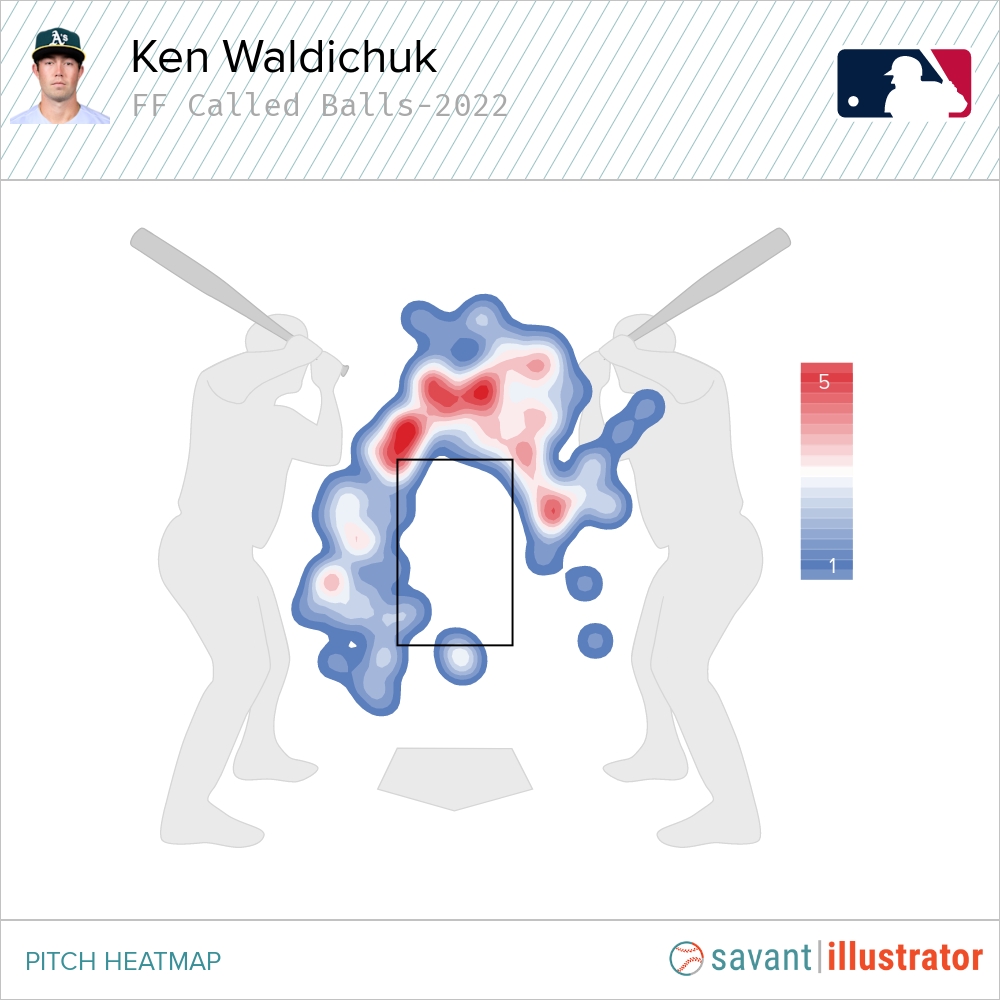
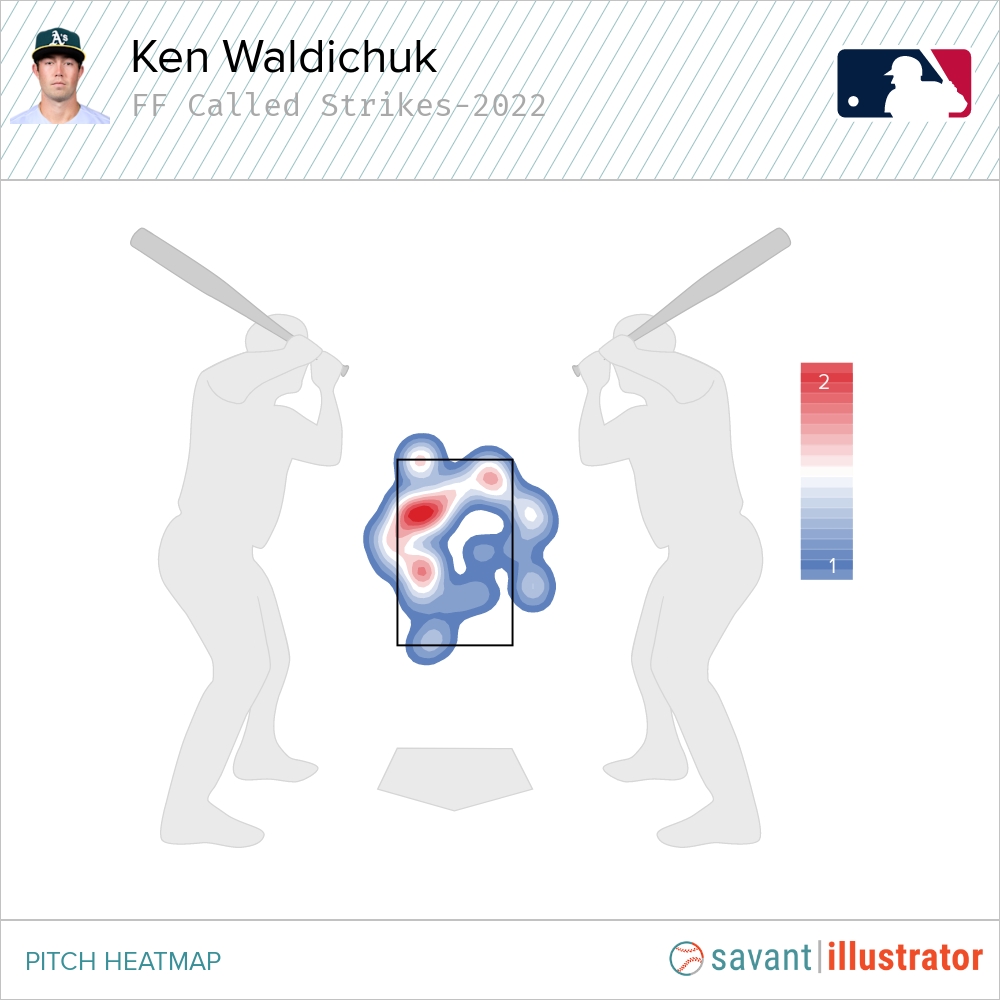
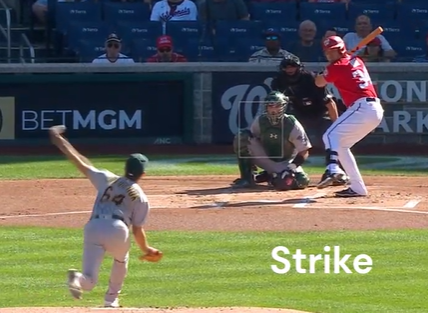
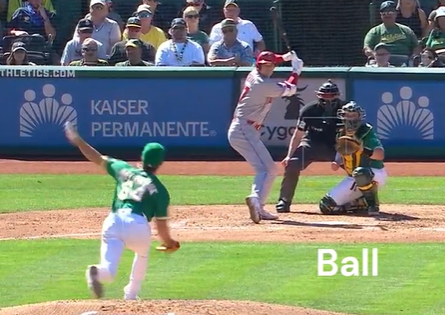
Waldichuk performed well in the minors, except for control issues. And, he is a starting pitcher who averaged less than 5 innings per start. Have we devolved to the point our starter can’t last long enough to qualify for a win, no matter how well he pitches? It wasn’t just one season or with one team that he threw so few innings. Every year. Every team. Isn’t he better suited as a long reliver? I remember Whitey Ford had a couple seasons when he got through 5 or so innings and Luis Arroyo finished his games. But we ain’t got no Luis Arroyo. A’s pitching roster is awful. A career era above 5 doesn’t disqualify you for this team. One of the best arms (Puk) is gone. He at least had potential and performed better than we have in his place.